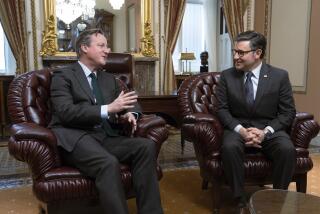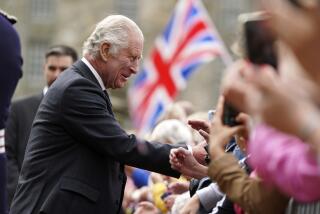Winston Churchill: Journey through the life of the ‘greatest Briton’
Commemorating the 50th anniversary of one politician’s death — and extending the recognition to a whole year, across an entire nation — might seem excessive. Unless that politician is Winston Churchill, and the nation is Britain.
“Our greatest Briton,” as the World War II prime minister is known here, took that office in 1940 professing to have “nothing to offer but blood, toil, tears and sweat.” Beyond merely delivering on that offer, he led the country, and the free world, in turning the tide against Adolf Hitler’s Germany, saving England from what seemed an inevitable invasion.
Five years later, the victory Churchill had envisioned freed Europe from a Nazi subjugation that he had warned would bring “the abyss of a new Dark Age.”
And so, the island nation has established Churchill 2015, tailoring a dozen tourist attractions to honor perhaps the 20th century’s most sagacious and colorful leader, and to teach visitors about him and his time.
The sites involved in Churchill 2015 include one of England’s most glamorous and conspicuous — dazzling Blenheim Palace in Oxfordshire, his ancestral home — and what is certainly its most hidden, buried under government buildings in London’s Whitehall district.
There, an expansive converted bomb shelter serves as one of the city’s finest historical display spaces: the Churchill War Rooms. Adjacent is its Churchill Museum, which since 2005 has housed England’s only exhibition devoted entirely to the 90-year life of the warrior-diplomat whose service extended from the era of horse-drawn artillery to the nuclear age.
Among other spots on this Churchill grand tour are the family home, Chartwell, in Kent, southeast of London; Bath, in the west; and Scarborough in the north; all mark stops in his amazing career.
For historians, this recognition couldn’t come soon enough.
“We’re in a moment when we’re seeing the wartime generation dying out and when Churchill himself is passing out of living memory,” said Allen Packwood, director of the politician’s archives at Churchill College in Cambridge.
Three key Churchill-related anniversaries converge this year. The two others: the 70th anniversary of the end of World War II, “and the 75th of Churchill’s finest hour in 1940,” Packwood noted, drawing on the famous phrase Churchill used to describe how history would view a British victory.
England’s Churchill 2015 tributes offer a chance to review our historical memory as well.
“These days, we dimly believe that the Second World War was won with Russian blood and American money … [but] it is also true that, without Churchill, Hitler would almost certainly have won,” writes London Mayor Boris Johnson in “The Churchill Factor,” the former journalist’s 2014 book. “Churchill matters today because he saved our civilization. And the important point is that only he could have done it.”
The War Rooms
Any Churchill trek best begins in London, at the War Rooms’ subway-stop of an entrance, just east of Westminster Bridge at the corner of St. James’s Park and not far from 10 Downing St. There, one follows stairs down to the subterranean bunker, developed to allow the British government to plan strategy safely as German air raids rained hell on the city above.
Churchill’s temporary residence is preserved, as are the rooms for cabinet sessions and for communicating with his generals and allies — including U.S. President Franklin D. Roosevelt.
With the claustrophobic feel intact, nearly half a million annual visitors get a vivid sense of how difficult it was to manage a war under such circumstances. Walking among the pillars, below the low-slung reinforced concrete, they peer through glass at open areas such as the map room, where battles were planned.
It is the museum area, though, that brings the amazing sweep of Churchill’s life into sharpest focus. Snippets from his wartime radio addresses waft through speakers, showcasing his often Shakespearean writing power and humor in the face of catastrophe that endeared him to many.
Although his wartime administration is the museum’s initial focal point, visitors quickly begin tracing the Churchill chronology through photos, starting with his patrician birth at the Blenheim estate in 1874 and his early gravitation toward military life.
Surprising to those who know only the World War II Churchill: the many personal and professional reversals he overcame through the years, including an escape from capture in South Africa’s Boer War in 1899, which brought him his first national renown. After entering politics and becoming first lord of the Admiralty, he was a force in promoting advanced weaponry, from tanks to airplanes, in the years before World War I. Told through film and audio, however, is the tale of his failed 1915 plan to take Constantinople. After a disastrous allied assault at Gallipoli, Churchill was dismissed, declaring privately, “I am finished.”
Much of his appeal reflects the way ordinary people can identify with his homely, flawed and occasionally comic side. “He’s human and has his faults,” said War Rooms director Phil Reed. “He smoked, he drank, he was conceited. Yet he brings people together because he’s such an inimitably strong leader.”
His World War II achievements dominate the museum space, of course, but his later life is hardly less compelling. Churchill’s return in the 1950s as prime minister showcases him as an elder statesman, with a keen, prophetic view of the changing political world.
Best known during this time for his dislike of communism — he coined the term “Iron Curtain” in a speech delivered in America — Churchill also was among the first to urge nuclear negotiations between the West and the Soviets. He had coined “summit” to describe all high-level talks among leaders, including those aimed at arms reductions. Although no such nuclear summits took place during his lifetime, his words were remembered in later years.
One fascinating interactive display lets museumgoers explore the development of Churchill’s writing and speaking style. Early in life, he overcame a severe lisp, something few suspected when the prime minister rallied his people. (Churchill “mobilized the language and sent it into battle,” according to John F. Kennedy, who as president made Churchill the first person to be granted honorary U.S. citizenship.)
By analyzing Churchillian word constructions, according to museum director Reed, visitors are able to explore the “instantly recognizable phrases of his best-known oratory, and to understand how Churchill came to hold the position he now does in the minds and hearts of people all around the world.”
Another riveting feature of the museum is the film coverage of Churchill’s Jan. 30, 1965, funeral, attended by leaders from around the globe. A reenactment of part of the funeral procession is planned for this year’s anniversary, with a barge making the journey on the River Thames just as it carried Churchill on his way to eventual burial in a churchyard near Blenheim Palace.
Blenheim
A 1 1/2-hour drive or train ride northwest of London in Oxfordshire, the Blenheim estate officially reopens Feb. 14, after an updating to ready it for the year’s celebrations. Blenheim does plan a memorial stroll for visitors through its Formal Gardens on Jan. 24 — the anniversary of the British leader’s death. Organizers of Churchill 2015 plan no other events for that day, considering it a private time for the Churchill family.
Like the London War Rooms, Churchill’s Blenheim Palace birthplace will serve as a centerpiece for remembering the great statesman. New photographs and artifacts will be displayed, including young Winston’s saddle for his pony Rob Roy.
The palace guides will give a 40-minute tour, and an interactive display, “Blenheim Palace: The Untold Story,” will feature discussions by animatronic members of the household staff across three centuries, taking a kind of “Downton Abbey” approach.
It is noted that Churchill’s mother, the former Jennie Jerome, was born in Brooklyn, N.Y. Of the 675,000 or so visitors expected this year, one in five probably will come from overseas, with half those being American. In mid-June, another memorial garden will open beside the estate’s Temple of Diana, where Churchill proposed to Clementine Hozier in 1908.
Buggy rides also are being added this year to take passengers to the nearby village of Bladon, where Churchill is buried in a family plot at St. Martin’s Church.
“It is remarkable that he chose to be buried at a small family churchyard, and not at Westminster Abbey,” said Churchill archives director Allen Packwood, who finds the choice well-suited to the man.
____
A timeline of Winston Churchill’s life
Nov. 30, 1874: Winston Churchill is born at Blenheim Palace, Oxfordshire, England. Father is Lord Randolph Churchill, a Tory politician. Mother is Jennie Jerome, an American.
April 17, 1888: Enters Harrow School.
Sept. 1, 1893: After struggling to pass entrance exams, Churchill finally does and enters the Royal Military College at Sandhurst.
December 1894: Graduates 20th in a class of 130.
January 1895: As a second lieutenant, Churchill joins the 4th Hussars.
Nov. 20, 1895: Churchill arrives in Cuba and sees action.
Sept. 11, 1896: Sails with regiment for India.
Aug. 2, 1898: Arrives in Cairo with the 21st Lancers.
1899: Resigns his commission, goes to South Africa as a war correspondent covering the Boer War. Taken prisoner in November.
Dec. 12, 1899: Escapes prisoner of war camp.
Oct. 1, 1900: Elected to the House of Commons.
Sept. 12, 1908: Marries Clementine Hozier.
October 1911: Appointed first lord of the Admiralty and sets about upgrading Britain’s navy. Shoulders much blame for the disaster of the Battle of Gallipoli, fought April 1915 until January 1916 in the Ottoman Empire. British Commonwealth casualties top 200,000.
November 1915: Resigns from government, becomes lieutenant colonel of the 6th Royal Scots Fusiliers.
July 17, 1917: Appointed minister of Munitions.
1919-21: Appointed secretary of state for war and air.
February 1921: Becomes British minister of Colonies, which manages Britain’s possessions; remains until October 1924.
Nov. 6, 1924: Becomes chancellor of the Exchequer (similar to secretary of Treasury). Serves until June 1929.
1930s: While largely excluded from office, writes the million-word “Marlborough: His Life and Times,” about ancestor John Churchill, the Duke of Marlborough, a general.
Sept. 3, 1939: Again appointed first lord of the Admiralty.
May 10, 1940: With resignation of Neville Chamberlain, Churchill becomes prime minister.
Nov. 28-Dec. 1, 1943: U.S. President Franklin Roosevelt, Churchill and Soviet Premier Joseph Stalin meet in Tehran to discuss, among other topics, the Allied plan against Germany.
May 15, 1944: Gen. Dwight Eisenhower, Field Marshal Bernard Montgomery, Churchill and King George VI review plans for June 6, 1944 — the D-day invasion of France.
Feb. 4-11, 1945: Churchill attends the Yalta Conference with Roosevelt and Stalin. Postwar reorganization is discussed, including the occupation of Germany.
July 26, 1945: Churchill resigns as prime minister.
March 5, 1946: In a speech at Westminster College in Fulton, Mo., Churchill speaks of the Iron Curtain.
Oct. 26, 1951: Churchill becomes prime minister a second time.
April 24, 1953: Queen Elizabeth II knights Churchill.
April 5, 1955: Churchill resigns as prime minister but remains in Parliament until 1964.
April 9, 1963: President Kennedy makes Churchill an honorary U.S. citizen. From his home in London, Churchill watches the ceremony on TV.
Jan. 24, 1965: Churchill dies at age 90. He is buried at St. Martin’s Church in Bladon.
Sources: Encyclopedia Britannica, the Churchill Centre, History Channel
____
If you go
THE BEST WAY TO LONDON
From LAX, nonstop service to London is offered by American, British, Air New Zealand, United, Virgin Atlantic and Delta. Connecting service (change of plane) is offered by United, Delta and KLM. Restricted round-trip fares range from $738 to $1,176.
TO LEARN MORE
For Churchill 2015 events, go to www.churchillcentral.com.
Churchill War Rooms (with link to the Churchill Museum), www.iwm.org.uk/visits/churchill-war-rooms
For Churchill 2015 events at Blenheim Palace, bit.ly/1xSoygE
More to Read
Sign up for The Wild
We’ll help you find the best places to hike, bike and run, as well as the perfect silent spots for meditation and yoga.
You may occasionally receive promotional content from the Los Angeles Times.






